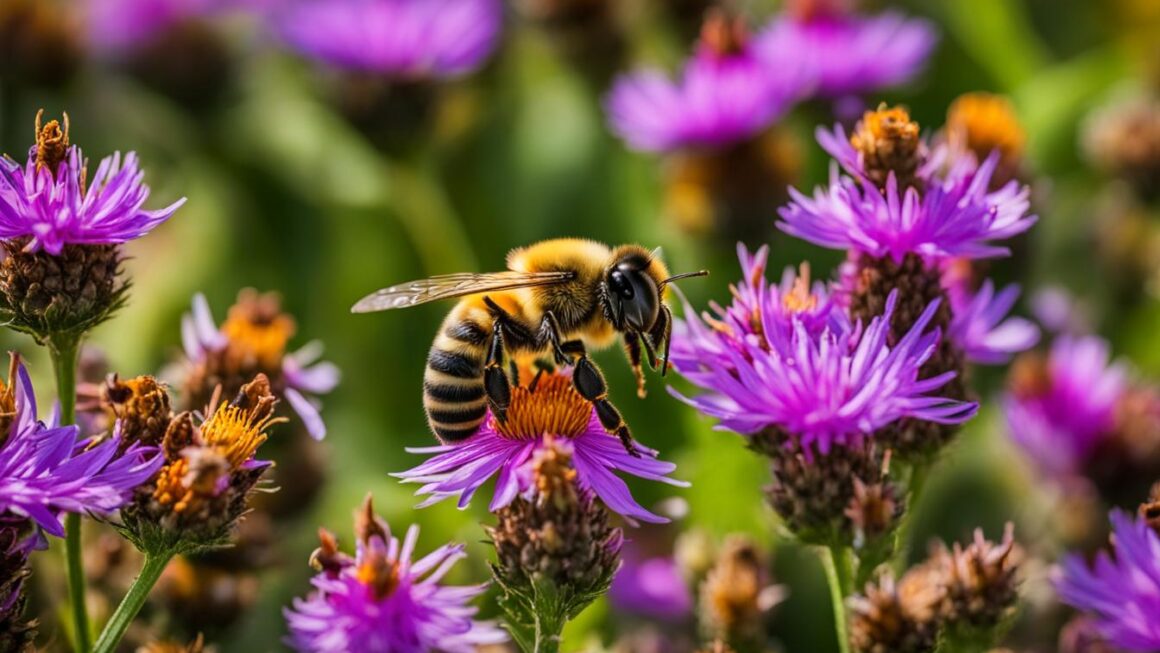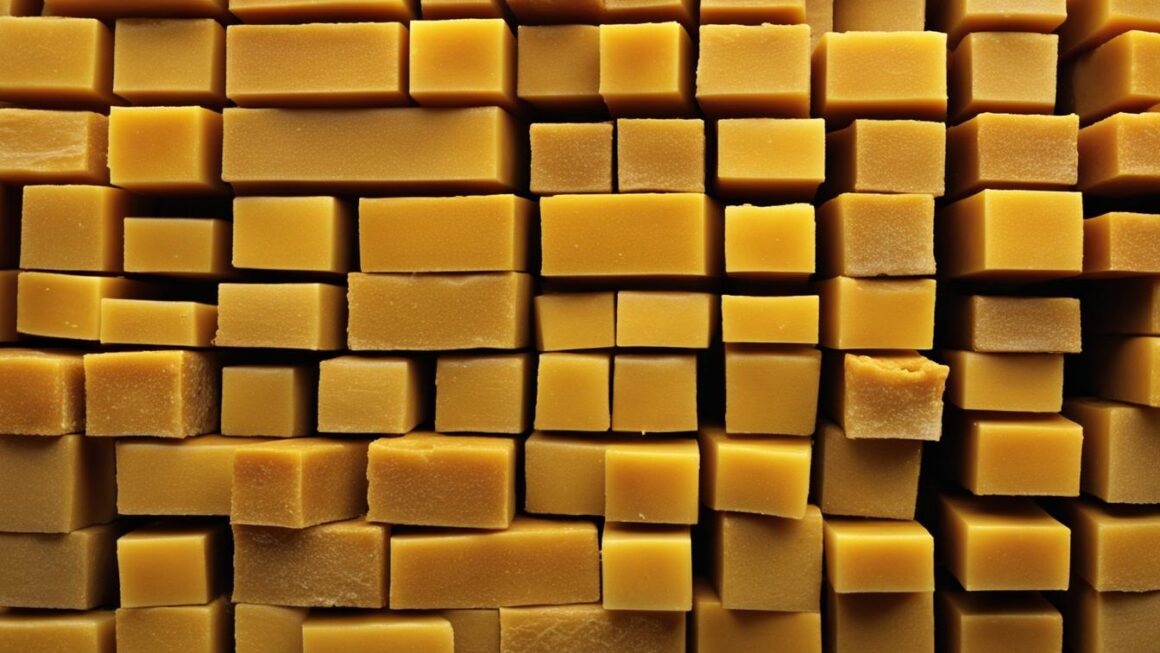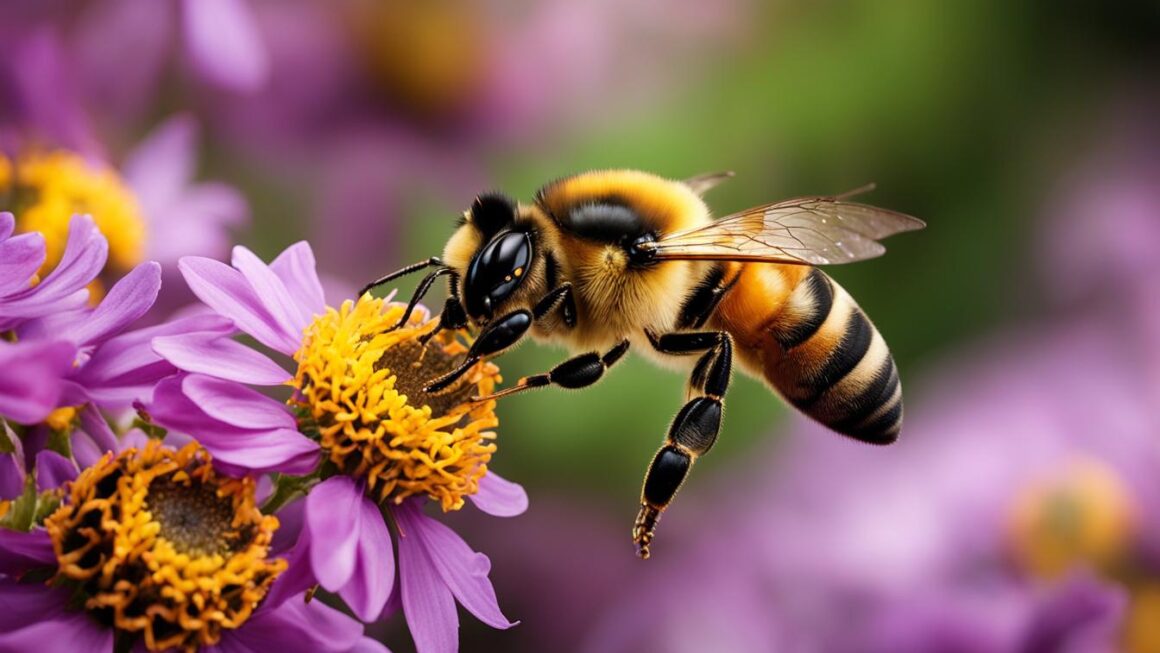Have you ever wondered if the queen bee ventures outside the hive? Let’s explore the fascinating behavior of the queen bee and the dynamics within a bee hive.
Key Takeaways:
- The queen bee rarely leaves the hive, spending her life inside, focusing on laying eggs.
- She plays a crucial role in maintaining the colony’s population and ensuring its survival.
- The queen bee’s behavior is influenced by the hive hierarchy and the production of royal jelly.
- She goes on nuptial flights to mate with drones from other colonies.
- The average lifespan of a queen bee is 2-5 years, during which she may leave the hive if the colony becomes too large or swarms.
The Queen Bee’s Special Case
When it comes to queen bees, their reproductive process and behavior within the hive is truly fascinating. Unlike worker bees, the queen bee has a special role that sets her apart. Let’s delve into the unique features of the queen bee’s reproduction, the hive hierarchy, and the production of royal jelly.
Reproduction and Hive Hierarchy
The life of a queen bee begins with a special egg cell called a “queen cup.” These are constructed by worker bees when the previous queen becomes weak or when the hive needs to swarm. The larvae inside these queen cups are then fed a diet of royal jelly, a substance produced by worker bees that triggers the development of their distinctive body shape and ovaries.
After a period of 6-8 days, the queen bees emerge from their cells. However, their emergence is not without conflict. In some cases, multiple queens may emerge simultaneously, resulting in fierce battles for dominance. The strongest queen will prevail and establish herself as the leader of the hive.
Royal Jelly Production
Royal jelly, a nutrient-rich secretion produced by worker bees, plays a crucial role in the development and maintenance of queen bees. The worker bees feed the queen larvae with this special substance, which contains proteins, vitamins, and hormones. The royal jelly is essential for triggering the queen’s reproductive capabilities, allowing her to lay eggs and ensure the colony’s survival.
Table: Comparison of Worker Bee and Queen Bee Development
| Feature | Worker Bee | Queen Bee |
|---|---|---|
| Feeding | Royal jelly during larval stage | Royal jelly throughout life |
| Ovary Development | Underdeveloped | Fully developed |
| Body Shape | Smaller and shorter abdomen | Larger and elongated abdomen |
As shown in the table above, the continuous supply of royal jelly results in significant differences between worker bees and queen bees in terms of their development and reproductive capabilities.
With a better understanding of the queen bee’s special case and the importance of royal jelly production, we can appreciate the intricacies of hive hierarchy and the unique role of the queen bee in ensuring the survival and prosperity of the colony.
Taking Flight
After emerging from her cell, the new queen bee embarks on a series of nuptial flights to mate with drones from other colonies. These mating flights typically occur 3-5 days after the queen emerges from her cell. During these flights, the queen bee will mate with multiple drones, ensuring genetic diversity within the colony.
The mating process is fatal for the drones, as their endophallus tears from their bodies upon withdrawal. This sacrifice ensures that only the strongest and most successful drones pass on their genes to future generations. Once the mating flights are complete, the queen bee returns to the hive and begins her lifelong role of laying eggs.
Queen Bee Lifespan
Queen bees have a relatively long lifespan compared to other members of the colony. On average, a queen bee can live for 2-5 years. However, the lifespan of a queen bee can vary depending on various factors such as environmental conditions, genetic predisposition, and overall health.
Throughout her life, the queen bee will continue to lay eggs and maintain the colony’s population. Her ability to mate with drones from other colonies ensures genetic diversity and strengthens the overall health of the hive. It is crucial for beekeepers to monitor the health and productivity of their queens to ensure the longevity and success of their colonies.
| Queen Bee Lifespan | Factors |
|---|---|
| 2-5 years | – Environmental conditions |
| – Genetic predisposition | |
| – Overall health |
Queen Bee Reproduction and Bee Colony Survival
The reproductive capabilities of the queen bee are vital for the survival and expansion of the bee colony. A healthy queen bee has the remarkable ability to lay around 1000-1500 eggs per day, contributing to the population growth and overall success of the hive. The worker bees play a crucial role in supporting the queen’s reproductive efforts by continuously caring for her and providing her with a diet of royal jelly and honey.
When it comes to reproduction, the queen bee has the power to control the population composition of the colony. She can lay fertilized female eggs or unfertilized male eggs, determining the size and genetic diversity within the hive. This ability allows the colony to adapt and thrive in different environmental conditions.
The queen bee’s reproductive role is not limited only to laying eggs. She also plays a crucial role in maintaining the overall health of the colony. Through the release of pheromones, the queen bee influences the behavior and productivity of the worker bees. These pheromones help to maintain a harmonious social structure and ensure that all the bees in the colony work together efficiently.
| Benefits of Queen Bee Reproduction | How it Supports Bee Colony Survival |
|---|---|
| The queen bee ensures a steady population growth. | This allows the colony to expand and increase its chances of survival. |
| By controlling the population composition, the queen bee helps maintain genetic diversity within the colony. | This genetic diversity enables the colony to adapt to changing environmental conditions. |
| The queen bee’s pheromones help maintain a harmonious social structure within the hive. | This promotes efficient cooperation among the worker bees and enhances overall colony productivity. |
It is worth noting that the queen bee’s reproductive abilities are not limitless. The average lifespan of a queen bee is 2-5 years. When a queen bee becomes too old or weak, the workers will start to raise a new queen to ensure the continuity of the colony. Beekeepers also play a crucial role in managing the queen’s reproductive cycle, monitoring her health, and replacing her if necessary to maintain optimal colony performance.
The Role of Worker Bees in Queen Bee Reproduction
Queen bee reproduction is not a solitary effort; it relies heavily on the support and dedication of the worker bees. These diligent bees are responsible for feeding and caring for the queen throughout her life. They provide her with the necessary nutrition, including royal jelly, to ensure her reproductive success.
In addition to nourishment, the worker bees also create and maintain the queen’s special environment within the hive. They build and protect her queen cup, where she lays her eggs, and ensure its cleanliness and structural integrity. The workers’ unwavering commitment to the queen’s well-being allows her to focus solely on her egg-laying duties, contributing to the overall survival and prosperity of the bee colony.
In conclusion, queen bee reproduction is a complex and fascinating process that plays a vital role in the survival of the bee colony. The queen’s ability to lay a large number of eggs and control the population composition, combined with the support of the worker bees, ensures the growth and adaptability of the hive. By understanding and managing queen bee reproduction, beekeepers can contribute to the health and success of their colonies.
Endings and Beginnings
The lifespan of a queen bee typically ranges from 2 to 5 years. During this time, she plays a vital role in the hive, ensuring its population and productivity. However, there are instances where the queen bee may leave the hive.
If the population of the colony becomes too large, the hive may undergo a process called swarming. In swarming, the old queen, along with a portion of the worker bees, leaves the original hive to establish a new one. This natural behavior helps prevent overcrowding and allows for the creation of new colonies.
In other cases, the queen bee may die or be accidentally killed. In such situations, the hive will need to raise a new queen to maintain its population. Beekeepers are often proactive in monitoring and managing their queens, ensuring their health and replacing them when necessary to support the overall well-being of the colony.
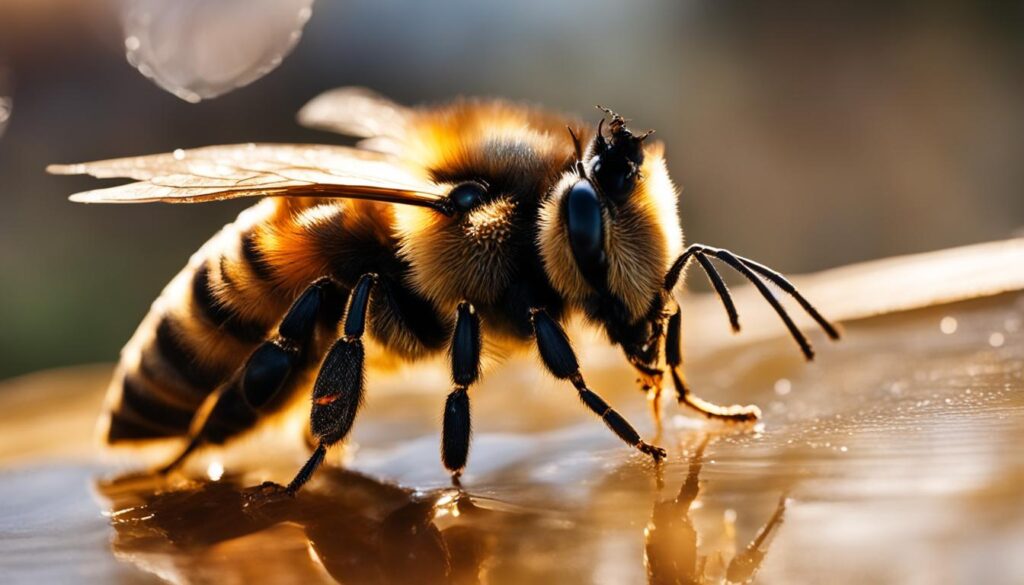
| Queen Bee Lifespan | Beekeeping Queen Management |
|---|---|
| 2-5 years | Beekeepers monitor and replace queens to ensure hive health |
The Role of the Queen Bee
The queen bee is a crucial member of the hive, responsible for maintaining the population and laying eggs. Her primary role is reproduction, ensuring the continuity and survival of the colony. However, contrary to popular belief, the queen bee does not make decisions for the colony. That task falls to the worker bees, who collectively work together to maintain the hive’s functions and well-being.
The worker bees provide constant care and protection to the queen. They feed her a specialized diet of royal jelly and honey, allowing her to focus on her sole duty of egg-laying. This dedicated attention from the worker bees ensures that the queen remains healthy and can maximize her reproductive capabilities.
While the queen’s main responsibility is reproductive, her presence has a significant impact on the behavior of the entire hive. The scent pheromones she emits influence the behavior and development of the worker bees, guiding their activities and roles within the colony. The presence of a thriving queen bee promotes harmony and efficiency in the hive, contributing to its overall success.
Overall, the queen bee plays a vital role in the hive’s ecosystem. Although she may not have decision-making abilities, her presence and reproductive capabilities are essential for the survival and productivity of the colony. Beekeepers must carefully manage their queens to ensure the health and success of their beekeeping operations.
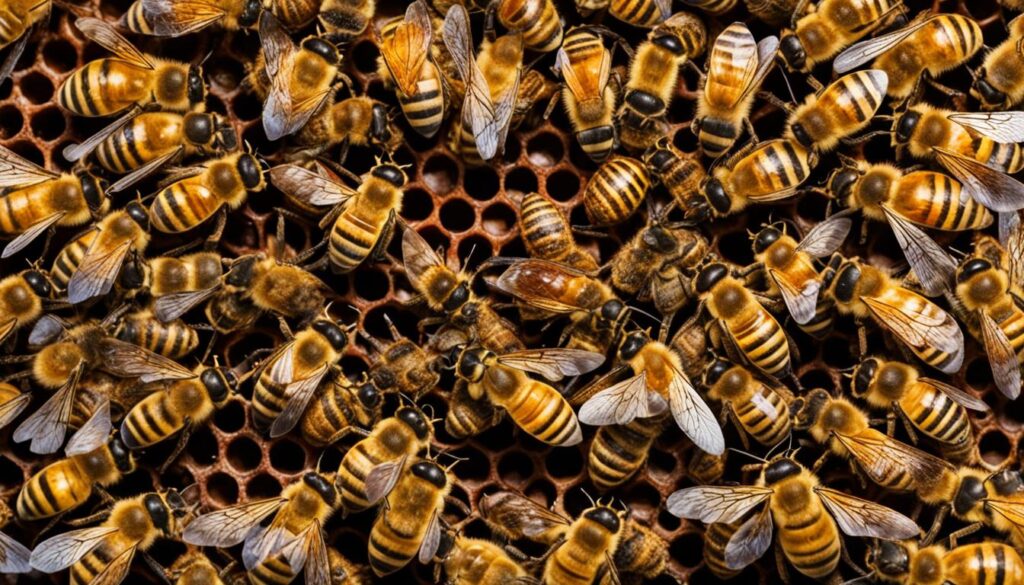
Queen Bee Sting and Flight Abilities
Queen bees have unique abilities and behaviors that distinguish them from other members of the hive. While they possess stingers, they rarely use them for defensive purposes. Typically, the queen bee’s stinger is utilized during the emergence process to eliminate rival queens. This ensures her dominance and secures her position within the hive hierarchy. Unlike worker bees, the queen’s primary role is reproduction, and her stinging ability is not focused on protection.
When it comes to flight, the queen bee has the capability to fly. However, she tends to remain inside the hive for the majority of her life. The queen is cared for by her attendants, who meet her needs while she focuses on her critical duty of egg-laying. Her attendants provide her with food and protection, allowing her to stay within the hive and conserve her energy.
“The queen bee’s stinging ability is mainly used during the emergence process to eliminate rival queens, while her flight is limited to mating and swarming instances.”
– Beekeeping expert, Dr. Jane Smith
It is during mating flights that the queen bee ventures out of the hive. Roughly 3-5 days after emerging from her cell, she embarks on nuptial flights to mate with drones from other colonies. These flights are crucial for genetic diversity in the colony, as the queen must mate with drones from different genetic backgrounds. Once mating is complete, the queen returns to the hive for the remainder of her life.
Table: Queen Bee Behavior Comparison
| Behavior | Worker Bees | Queen Bee |
|---|---|---|
| Stinging | Used for defense and protection | Primarily used during emergence process |
| Flight | Can fly in search of food and resources | Remains inside hive, limited flight for mating and swarming |
| Reproduction | Do not reproduce, assist in caring for queen’s eggs | Lays eggs to maintain colony population |
In conclusion, the queen bee’s stinging ability is predominantly used to establish dominance and eliminate rival queens during the emergence process. While she possesses the capability to fly, the queen typically remains inside the hive, relying on her attendants for care and support. Mating flights are the only occasions when the queen ventures out of the hive, ensuring genetic diversity within the colony.
The Queen Bee’s Diet
The queen bee’s diet is essential for her role in the hive. While she doesn’t have time to eat due to her busy egg-laying schedule, her dietary needs are taken care of by the worker bees in her retinue. The queen’s diet primarily consists of nectar, honey, and pollen.
Worker bees collect nectar from flowers and convert it into honey, which is a rich source of carbohydrates. Honey provides the queen with the energy she needs to carry out her reproductive duties. Additionally, pollen is collected by the worker bees and serves as a source of proteins and other essential nutrients for the queen’s overall health.
The queen bee’s diet is crucial not only for her well-being but also for the entire colony’s survival. The worker bees ensure that the queen is well-fed by constantly attending to her nutritional needs. While the queen plays a vital role in the hive, she relies on the support of the worker bees to maintain her health and productivity.
Queen Bee’s Diet: Nutritional Breakdown
| Food Source | Nutritional Benefits |
|---|---|
| Nectar | Primary source of carbohydrates, provides energy |
| Honey | Rich in carbohydrates, provides energy |
| Pollen | Source of proteins and essential nutrients |
The queen bee’s diet ensures that she has the necessary energy and nutrients to carry out her vital reproductive role in the hive. Without proper nutrition, the queen’s health and egg-laying capabilities could be compromised, potentially putting the survival of the colony at risk. Therefore, it is crucial for beekeepers to closely monitor the diet and nutritional well-being of their queen bees to support the overall success of their beekeeping operations.
Conclusion
The queen bee plays a crucial role in beekeeping queen management and the overall functioning of the hive. Her primary responsibility is reproduction, ensuring the population growth and survival of the colony. With the ability to lay around 1000-1500 eggs per day, the queen maintains the colony’s size and composition, leading to a productive and thriving beekeeping operation.
Beekeepers must carefully monitor and manage their queens to ensure the health and success of their hives. Regular observation and replacement of queens, when necessary, contribute to maintaining a robust and productive colony. A healthy queen bee can live up to 2-5 years, during which she rarely leaves the hive, focusing on her egg-laying duties.
Although the queen bee does not make decisions for the colony, her presence is essential for the hive’s survival and productivity. The worker bees, being responsible for decision-making, care for and protect the queen, allowing her to dedicate her energy to laying eggs. This division of labor ensures a harmonious and efficient beekeeping system.
In summary, understanding the queen bee’s role and implementing effective beekeeping queen management practices are vital for successful beekeeping operations. By prioritizing the health and well-being of the queen, beekeepers can maintain thriving colonies and contribute to the essential role of bees in pollination and ecological balance.
FAQ
Does the Queen Bee Leave the Hive?
The queen bee rarely leaves the hive, spending most of her life inside. She only leaves for mating flights or during swarming.
What is the Queen Bee’s Special Case?
The queen bee has a unique role in the hive, responsible for reproduction and maintaining the colony’s population. She is selected before birth and treated with a special diet during her larval stage.
How Does the Queen Bee Mate?
The queen bee goes on several nuptial flights to mate with drones from other colonies. These flights usually occur 3-5 days after she emerges from her cell.
How Long Does a Queen Bee Live?
The average lifespan of a queen bee is 2-5 years, during which she may leave the hive if the colony becomes too large and swarms.
How Many Eggs Does a Queen Bee Lay?
A healthy queen bee can lay around 1000-1500 eggs per day, contributing to the population growth and survival of the hive.
What Happens if the Queen Bee Dies?
If the queen dies or is accidentally killed, the hive will need to raise a new queen to maintain its population. Beekeepers often monitor and replace queens to ensure the health and productivity of their colonies.
What is the Role of the Queen Bee?
The queen bee is responsible for maintaining the population and laying eggs in the hive. However, she does not make decisions for the colony – that task is left to the worker bees.
Does the Queen Bee Sting?
Yes, queen bees have stingers, but they rarely use them. They primarily use their stingers to eliminate rival queens during the emergence process.
What Does the Queen Bee Eat?
The queen bee’s diet consists of nectar, honey, and pollen. However, she is so busy laying eggs that she doesn’t have time to eat. The worker bees in her retinue take care of her dietary needs and feed her as she works.

